When it comes to cleaning your pet’s water bottle, starting with a systematic approach is key. Begin by removing the bottle from its place and pouring out any remaining liquid.
Unscrew the cap or sipper tube and proceed to wash the bottle with care. But that’s just the first step in ensuring your furry friend’s hydration source is spotless and safe.
Key Takeaways
- Regular cleaning prevents harmful bacteria and algae buildup.
- Use necessary supplies like dish detergent and bottle brush for thorough cleaning.
- Maintain cleanliness by disinfecting weekly and understanding bottle mechanics.
- Monitor bottle condition, dryness, and pet’s water intake for optimal health benefits.
Importance of Cleaning Pet Water Bottles
Regularly cleaning your pet’s water bottle is essential to maintain their health and prevent the buildup of slime, dirt, and algae. Pet water bottles, if left uncleaned, can become breeding grounds for harmful bacteria and algae, posing a risk to your pet’s well-being. Ensuring that your pet has access to clean water is paramount in maintaining their health and preventing potential illnesses.
Cleaning pet water bottles involves more than just rinsing them out. Using a specialized pet water bottle brush is critical for effectively removing any slime or residue that may have accumulated inside the bottle. This brush can reach crevices that regular cleaning tools can’t, ensuring a thorough cleaning process.
In addition to physical cleaning, regularly disinfecting your pet’s water bottle is equally important. A simple solution of 10 parts water to 1 part bleach can be used to disinfect the bottle. This helps in killing any bacteria present and preventing their growth, keeping the water fresh and safe for your pet.
Necessary Supplies for Cleaning
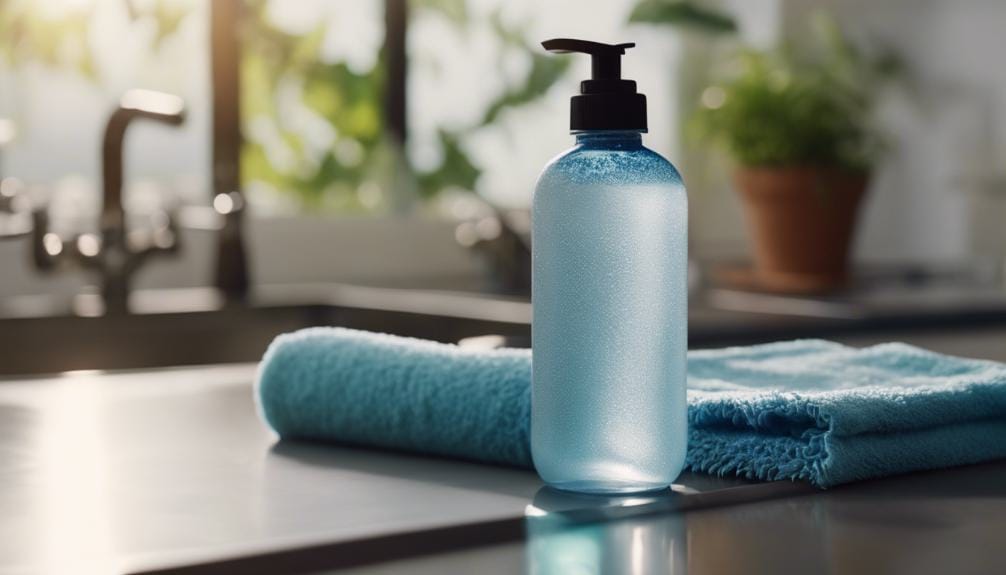
To effectively clean your pet’s water bottle, gather necessary supplies such as liquid dish detergent, a bottle brush, white rice, vinegar, and baking soda. These items are essential for maintaining a clean and safe water container for your pet. The liquid dish detergent will help remove any grease or dirt buildup inside the bottle. A bottle brush is important to scrub hard-to-reach areas and guarantee a thorough cleaning.
White rice is a surprising yet effective tool in cleaning pet water bottles. When swirled around with soapy water, the rice acts as a natural scouring agent, helping to dislodge any residue stuck to the bottle’s walls. Vinegar and baking soda are excellent additions to your cleaning routine. Vinegar’s acidity can help break down tough deposits, while baking soda works as a gentle abrasive to scrub away grime.
Taking care of your pet’s plastic bottles with these supplies is essential to prevent algae buildup, contamination, and keep your pet healthy. Regular cleaning using soapy water, white rice, vinegar, and baking soda will guarantee a fresh and safe water supply for your furry friend. Remember to rinse the bottle thoroughly after cleaning to remove any cleaning residue before refilling it with fresh water for your pet.
Step-by-Step Cleaning Instructions
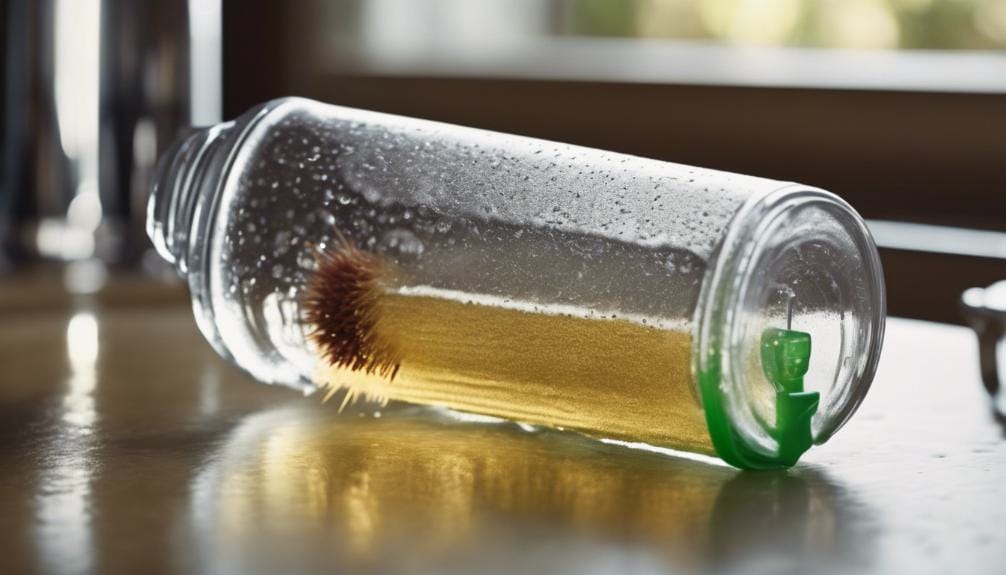
After removing and emptying the water bottle from the cage, wash it with liquid dish detergent and warm water. Make sure you cover all areas of the bottle, inside and out, to remove any dirt or residue. Here is a step-by-step guide to effectively clean your pet’s water bottle:
| Step | Instructions |
|---|---|
| 1. Initial Rinse | Rinse the bottle with warm water to remove any visible debris or leftover water. |
| 2. Washing | Use a small amount of liquid dish detergent and warm water to wash the interior and exterior of the bottle. |
| 3. Bottle Brush | For stubborn residue, utilize a bottle brush to scrub the inside of the bottle thoroughly. |
| 4. Sipper Tube | Clean the sipper tube separately with warm water and a bottle brush to make sure of proper hygiene. |
After following these steps, make sure to refill the bottle with fresh water and securely reattach the sipper tube. To dry hard to reach places, shake the bottle gently or use a soft cotton swab. Remember to avoid using boiling water on plastic bottles and always refer to the care instructions for maintenance guidelines. Your pet’s water bottle will now be clean and ready for use!
Tips for Maintaining Cleanliness

When maintaining the cleanliness of your pet’s water bottle, making sure regular cleaning and proper disinfection is crucial to preventing any buildup of slime, dirt, or algae. Here are some essential tips to help you sustain the cleanliness of your pet’s water bottle:
- Utilize a Water Bottle Brush: Invest in a specialized water bottle brush designed to reach all corners of the bottle and scrub off any stubborn residue. This will guarantee a thorough cleaning process and help prevent any buildup that might occur over time.
- Consistent Disinfecting: Plastic water bottles should be disinfected weekly using a solution of 10 parts water to 1 part bleach. This will help kill any harmful bacteria or algae that may be present in the bottle, keeping your pet’s water source clean and safe.
- Understanding Lixit Water Bottles: If you use Lixit water bottles for your pet, make sure to familiarize yourself with their mechanics. Understanding how these bottles work can help you prevent leaking and dripping issues, making sure that your pet always has access to clean water.
Final Checks and Precautions
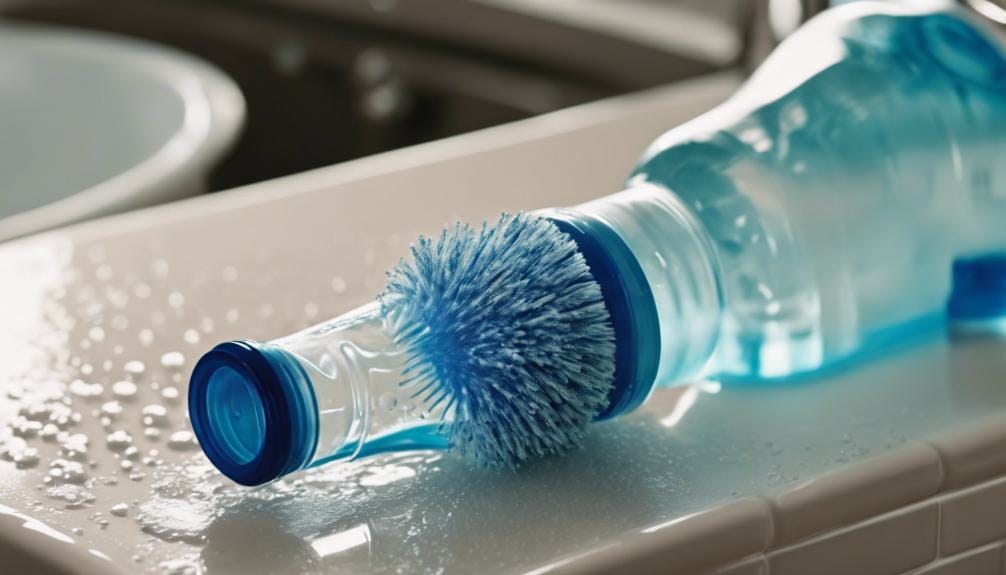
Perform a thorough inspection of the water bottle, making sure it is free from any defects or contaminants that could harm your pet’s health. Check for cracks, leaks, or any signs of wear and tear that may have developed over time. It’s essential to make sure the bottle is in best condition to provide clean drinking water for your beloved pet. Here are some final checks and precautions to think about before allowing your pet to use the water bottle:
| Checklist | Action Needed | Importance |
|---|---|---|
| Bottle Integrity | Inspect for cracks, leaks, or damage | Ensures water is contained securely |
| Sipper Tube Examination | Check for blockages or signs of wear and tear | Maintains proper water flow to your pet |
| Dryness Verification | Make sure the bottle is completely dry before refilling | Prevents mold growth |
| Disinfection Routine | Use pet-safe disinfectant periodically | Prevents bacterial growth |
| Water Intake Monitoring | Monitor your pet’s water consumption regularly | Ensures they are drinking enough from a clean source |
In the latest news, maintaining a clean water bottle for your pet is essential for their well-being. If you need help or have any concerns about your pet’s drinking water habits, consult a veterinarian for guidance. By following these final checks and precautions, you can make sure your pet has access to safe and clean drinking water at all times.
Frequently Asked Questions
How Do You Clean the Inside of a Pet Water Bottle?
To clean the inside of a pet water bottle, scrub with a bottle brush, rinse with warm water, and consider using white rice for tough spots. Soak in vinegar or baking soda, ensuring dryness before refilling to prevent mold.
How Do You Get Green Algae Out of a Pet Water Bottle?
To get green algae out of a pet water bottle, soak it in 100% white vinegar. Diluted vinegar also works. Rinse thoroughly after cleaning to remove algae residue. Providing multiple dispensers and regular cleaning prevent algae growth.
How Do You Clean a Pet Bottle?
To clean a pet bottle, unscrew the cap, wash with dish detergent and warm water, scrub stubborn residue with a bottle brush, rinse thoroughly, refill with fresh water, reattach the sipper tube carefully, and avoid contamination.
How Do You Clean a Pet Water Dispenser?
To clean a pet water dispenser, start by emptying and removing the bottle. Scrub with a pet water bottle brush and soapy water to remove slime. Disinfect by using 10 parts water to 1 part bleach. Rinse thoroughly. Regular maintenance prevents algae growth.
Conclusion
To sum up, proper cleaning of your pet’s water bottle is vital for their health and well-being. By following the steps outlined in this article and using the necessary supplies, you can guarantee that your pet always has access to clean and fresh water.
Regular maintenance and thorough cleaning will help prevent bacteria buildup and keep your pet healthy and happy. Remember to always follow care instructions and take necessary precautions for effective cleaning.

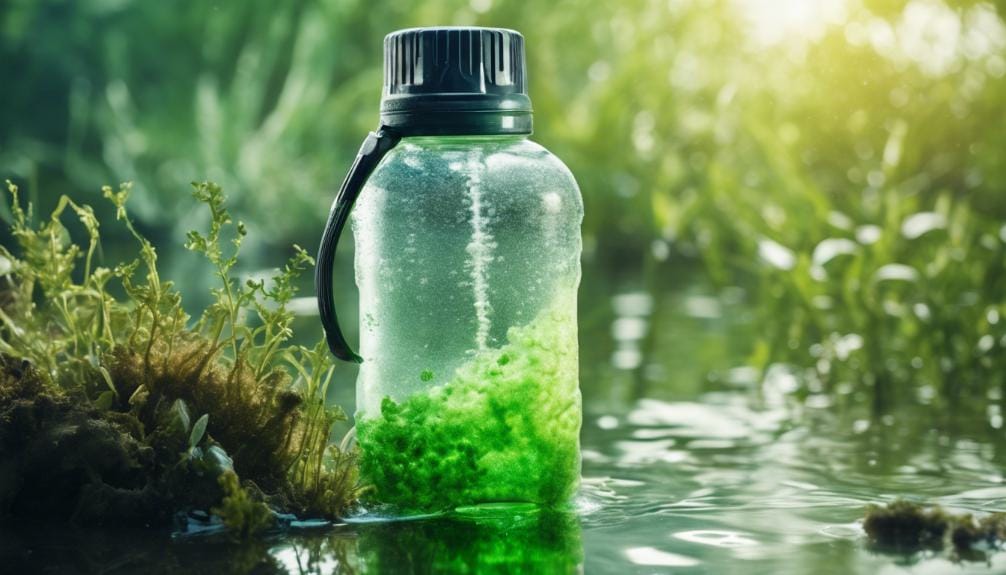
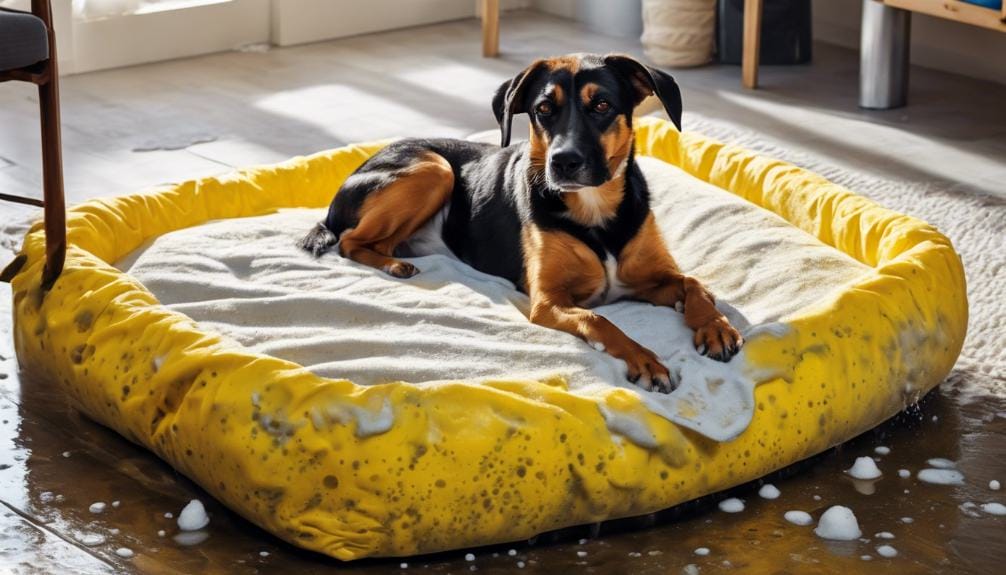
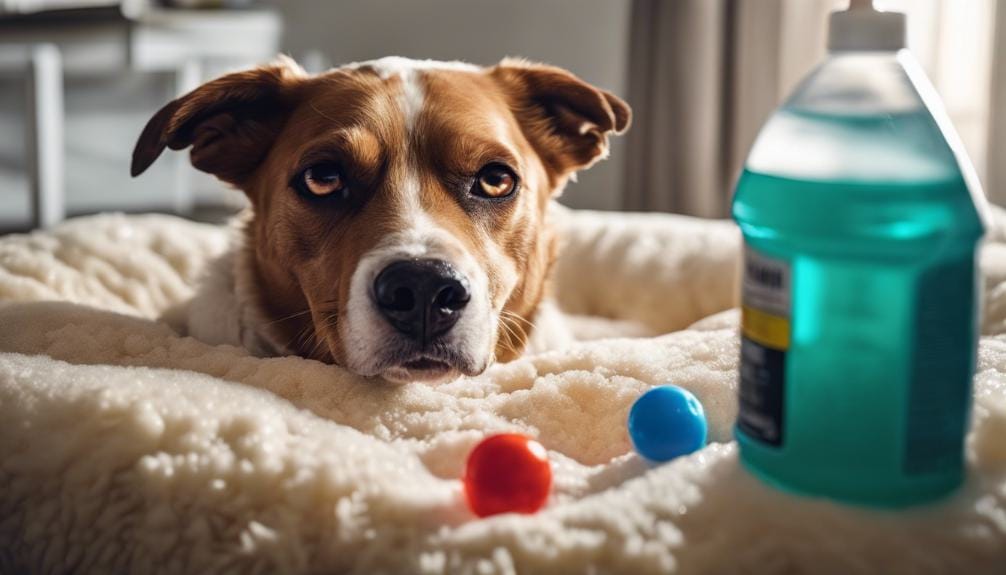
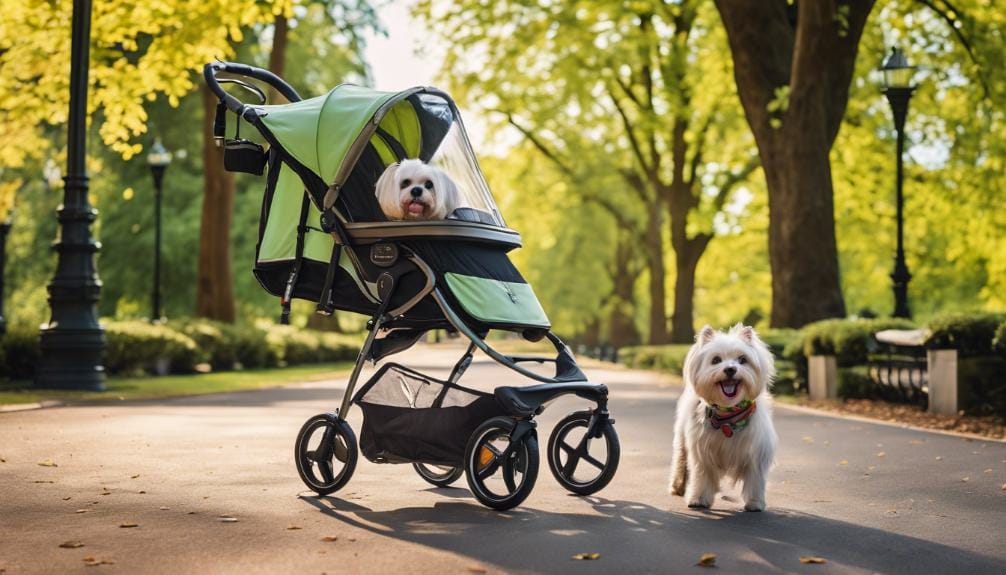
Leave a Reply
You must be logged in to post a comment.